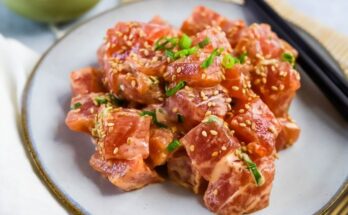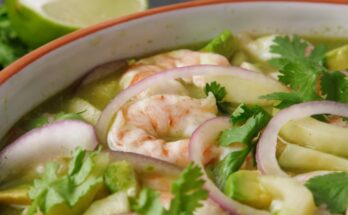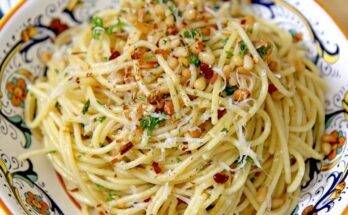Bottom Round Roast Recipe: The bottom round roast is a budget-friendly, lean cut of beef taken from the rear leg of the cow. It’s naturally tough due to its low fat content, but with the right cooking techniques, it transforms into a tender, flavorful dish. Known for its rich beefy flavor, it’s perfect for family dinners or special occasions when paired with the right seasonings and sides.
So why choose this cut? For one, it’s affordable and versatile. You can roast it, slow-cook it, or even use leftovers in sandwiches and salads. With a few simple steps, you’ll have a delicious roast that melts in your mouth!
Ingredients Needed
Here’s what you’ll need to make a perfect bottom round roast:
Main Ingredients:
- 3-4 pound bottom round roast
- 2 tablespoons olive oil
- 3 teaspoons kosher salt (adjust as needed)
- 2 teaspoons black pepper
- 2 teaspoons garlic powder
- 1 teaspoon onion powder
- 1 teaspoon dried thyme
Optional Ingredients:
- 2-3 cloves minced garlic
- 1 tablespoon Worcestershire sauce
- Fresh herbs like rosemary or parsley for garnish
- Vegetables (e.g., carrots, potatoes, onions) for roasting alongside the meat
These ingredients create a flavorful, well-balanced roast, but feel free to customize seasonings to your taste.
Equipment Required
To prepare your roast efficiently, you’ll need:
Essential Tools:
- Roasting pan or baking sheet with a wire rack
- Meat thermometer
- Large skillet for searing
- Sharp carving knife
Optional Extras:
- Basting brush
- Aluminum foil (for tenting during resting)
- Oven-safe meat probe (for continuous temperature monitoring)
Having the right tools ensures you cook the roast evenly and safely while making the process smoother.
Preparing the Bottom Round Roast
Before you get to cooking, proper preparation is key to a successful roast.
- Trim the Roast: Remove any large pieces of excess fat on the surface. While a thin fat layer can help with moisture retention, too much fat can cause uneven cooking.
- Season Generously: Coat the roast with olive oil to help the seasonings stick. Mix your salt, pepper, garlic powder, onion powder, and thyme, then rub the mixture evenly over the entire roast. For deeper flavor, you can poke small holes in the roast and insert minced garlic.
- Let It Rest: Allow the roast to sit at room temperature for 30 minutes. This helps the meat cook evenly in the oven later.
Marinating the Roast (Optional)
If you want to enhance the flavor or tenderize the roast further, marinating is an excellent step.
Why Marinate?
Marinades can add both flavor and moisture to lean cuts like bottom round. They often include acidic components (like vinegar or lemon juice) that help break down tough muscle fibers.
Simple Marinade Recipe:
- 1/4 cup olive oil
- 2 tablespoons red wine vinegar
- 2 tablespoons soy sauce
- 1 tablespoon Dijon mustard
- Fresh herbs of your choice
Combine the ingredients and let the roast marinate in the refrigerator for 2-6 hours. Remember to pat it dry before searing.
How to Sear the Bottom Round Roast
Searing the roast locks in juices and adds a delicious crust.
Steps for Searing:
- Heat a large skillet over medium-high heat.
- Add 1-2 tablespoons of olive oil and let it get hot.
- Place the roast in the skillet and sear each side for 2-3 minutes, or until a deep brown crust forms. Avoid moving the roast around too much during this process.
Searing doesn’t fully cook the meat but ensures the final roast will have rich, complex flavors.
Roasting the Bottom Round Roast
Now comes the main cooking event—roasting!
- Preheat Your Oven: Set the oven to 325°F (163°C) for a slow, even roast.
- Place the Roast on a Rack: Use a roasting pan with a wire rack to allow air circulation. This prevents the roast from sitting in its own juices, which can make the bottom soggy. If adding vegetables, arrange them around the roast.
- Calculate Cooking Time: As a general guide, roast for 20-25 minutes per pound for medium-rare (135°F internal temperature). Adjust based on your desired doneness.
- Check the Temperature: Insert a meat thermometer into the thickest part of the roast. When the desired temperature is reached, remove the roast from the oven.
Checking for Doneness
Achieving the right level of doneness is crucial. Use the chart below to guide you:
| Doneness Level | Internal Temperature | Appearance |
|---|---|---|
| Rare | 125°F (52°C) | Red, cool center |
| Medium-Rare | 135°F (57°C) | Warm, pink center |
| Medium | 145°F (63°C) | Slightly pink center |
| Well-Done | 160°F (71°C) | No pink, fully cooked |
Always let the thermometer sit for a few seconds to get an accurate reading.
Resting the Roast
Resting the roast is an often overlooked but crucial step. Skipping this can lead to dry, tough meat as the juices escape when slicing.
- Tent with Foil: Remove the roast from the oven and loosely cover it with aluminum foil. Avoid wrapping it tightly to prevent the crust from becoming soggy.
- Rest for 15-20 Minutes: Letting the roast rest allows the juices to redistribute throughout the meat, resulting in a tender and juicy bite. During this time, the internal temperature may rise by about 5-10°F due to residual heat.
By following this step, you’ll ensure that each slice is packed with flavor and moisture.
Slicing the Bottom Round Roast
Slicing the roast properly is just as important as cooking it correctly. The wrong slicing technique can result in tough, chewy bites.
- Use a Sharp Knife: A dull blade will tear the meat instead of cutting it cleanly. A carving knife or a serrated knife works best.
- Slice Against the Grain: Look at the roast and notice the direction of the muscle fibers (the “grain”). To ensure tenderness, slice perpendicular to these fibers. Thin slices are ideal for maximum tenderness.
- Slice Gently: Avoid pressing down too hard, as this can squeeze out the juices. Let the knife glide smoothly through the meat.
By slicing correctly, you’ll maximize the tenderness and flavor of your roast.
Serving Suggestions
A bottom round roast is versatile and pairs well with a variety of side dishes. Here are a few ideas to complement your meal:
Classic Sides:
- Mashed Potatoes: Creamy, buttery mashed potatoes provide a comforting contrast to the roast’s savory flavors.
- Roasted Vegetables: Carrots, potatoes, and Brussels sprouts roasted alongside the meat soak up the delicious drippings.
- Steamed Green Beans: A simple yet refreshing option that adds color and balance to your plate.
Creative Serving Ideas:
- Roast Beef Sandwiches: Thinly sliced roast served on a toasted bun with horseradish mayo or au jus.
- Beef Salad: Toss leftover slices into a salad with arugula, cherry tomatoes, and a balsamic vinaigrette.
- Tacos: Shred the roast and use it as a filling for tacos with your favorite toppings.
The right sides and presentation can elevate your roast from a simple meal to a gourmet experience.
How to Make a Gravy or Sauce (Optional)
Roast drippings are a treasure trove of flavor and can be transformed into a rich, savory gravy.
Simple Gravy Recipe:
- Collect the Drippings: After roasting, pour the drippings into a saucepan, leaving behind any large solids.
- Create a Roux:In a separate pan, melt 2 tablespoons of butter and whisk in 2 tablespoons of flour. Cook for 2-3 minutes until golden brown.
- Combine and Simmer: Slowly whisk the drippings into the roux, stirring constantly to prevent lumps. Add beef stock if needed to reach your desired consistency. Season with salt and pepper.
- Optional Add-Ins: Add a splash of red wine, Worcestershire sauce, or fresh herbs for extra depth of flavor.
Pour the gravy over your roast or serve it on the side for dipping.
Tips for a Perfect Bottom Round Roast
Achieving the perfect roast is easier with these expert tips:
- Don’t Overcook: Bottom round is lean and can become dry if overcooked. Stick to recommended temperatures for your desired doneness.
- Season Liberally: Since this cut has minimal fat, generous seasoning enhances the flavor. Rub the spices thoroughly into the meat before roasting.
- Use a Meat Thermometer: Guessing the doneness is risky. A thermometer ensures precision and prevents overcooking.
- Let It Rest: Resting is non-negotiable. This step locks in the juices, making each bite tender and juicy.
Avoiding common mistakes and following these tips will take your roast to the next level.
Storing and Reheating Leftovers
Got leftovers? No problem! Here’s how to store and reheat them without sacrificing quality.
Storage:
- Place leftover slices in an airtight container.
- Add a small amount of the roast’s juices or broth to keep the meat moist.
- Store in the refrigerator for up to 3-4 days or freeze for up to 3 months.
Reheating:
- For best results, reheat slices in a covered dish with a splash of beef broth at 300°F (150°C) for 10-15 minutes.
- Avoid microwaving, which can dry out the meat. If using a microwave, cover the meat and add a bit of moisture.
By storing and reheating correctly, your leftovers will taste just as good as the original roast.
FAQs about Bottom Round Roast Recipe
What is a bottom round roast?
A bottom round roast is a cut of beef from the rear leg of the cow. Known for its lean texture, it’s ideal for roasting, resulting in flavorful and tender meat when cooked properly.
How long should I cook a bottom round roast?
The cooking time for a bottom round roast depends on the size of the roast and your desired level of doneness. Generally, you should roast it in an oven at 325°F (165°C), allowing about 20-25 minutes per pound for medium rare.
What temperature should a bottom round roast be cooked to?
For the best results, cook your bottom round roast to an internal temperature of 135°F (57°C) for medium rare. Allow it to rest before slicing so the juices can redistribute throughout the meat, raising the final temperature to around 145°F (63°C).
Should I marinate a bottom round roast?
Marinating a bottom round roast can enhance its flavor and tenderness. A marinade containing acids like vinegar or lemon juice is particularly effective. Marinate in the refrigerator for several hours or overnight for the best results.
Can I cook a bottom round roast in a slow cooker?
Yes, cooking a bottom round roast in a slow cooker is an excellent way to ensure it becomes tender and retains moisture. Cook it on low for 8 hours with your choice of broth and vegetables for a delicious, effortless meal.
What are the best seasonings for a bottom round roast?
Herbs and spices like rosemary, thyme, garlic, salt, and pepper are perfect for enhancing the natural flavors of a bottom round roast. Experiment with your favorite seasonings to tailor the taste to your liking.
How do I keep my bottom round roast from drying out?
To prevent your roast from drying out, cook it at a low temperature and use a meat thermometer to avoid overcooking. Additionally, basting the roast with its juices or a marinade during cooking can help keep it moist.



